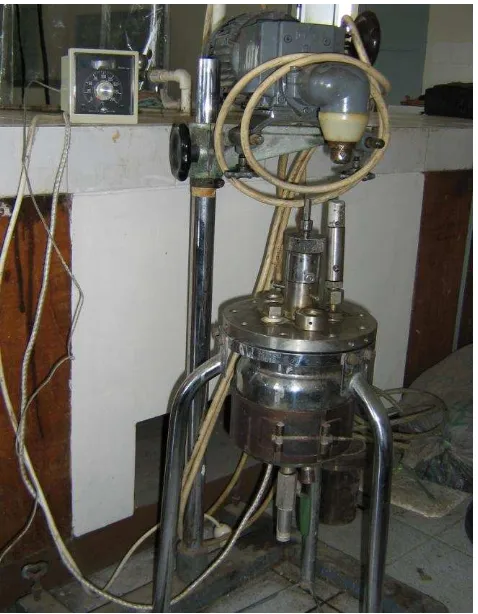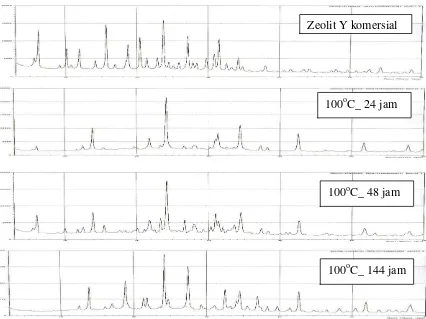THE UTILIZATION OF RICE HUSK ASH FOR PRODUCTION ZEOLITE SYNTHESIS Y
DIDI DWI ANGGORO
Chemical Reaction Engineering and Catalysis Lab., Chemical Engineering Department, Diponegoro University, Tembalang, Semarang
Telp./Fax. 024-7460058; E-mail: [email protected]
ABSTRACT
Rice husk is the milling byproduct of rice and is a major waste product of the agriculture industry. Amorphous silica, commonly referred to as rice husk ash, was extracted from rice husk by acid leaching, pyrolysis, and carbon-removing processes. On the other hand, the pure silica with a high specific surface area, high melting point and high porosity can be obtained from rice husks. These properties make the ash a valuable raw material for many industries. This paper is study of synthesized of zeolite Y from rice husk ash. Zeolite Y synthesis is used for petroleum industry as expensive catalyst. Rice husk was calcined at temperature 700oC for two hours using furnace to produce pure silica . The composition of synthesized of zeolite Y from rice husk was 2.24 Na2O : Al2O3 : 8 SiO2 : 112 H2O. The gel solution was mixed at room temperature for 24 hours using autoclave. Then, the gel solution was heated with variable temperature and time crystallization. The product zeolite synthesis Y was filtered and washed with distilled water until pH lower than ten, than dried at oven. This product was analyzed with X-Ray Diffraction (XRD). From XRD analyze result
indicated that from rice husk ash can produced zeolite synthesis Y which high structure and crystallization degree. The optimum condition for synthesized zeolite Y from rice husk ash was temperature 100oC for 48 hours.
Keyword: Rice Husk Ash, Synthesized, Zeolite Y
INTRODUCTION
The present world rice production of about 400 million tons per year will probably increase in the future, owing to the great increase in population, particularly in Asian countries. When rice grains are husked, the husks make up about 14 to 35%, depending on the variety of rice; since the husks have a low bulk weight of about 100 kg/m3, they take up 560 to 1400 million m3. In Indonesia, rice husk ash is produced in abundance after every rice harvesting reason [1].
Chemical analysis of rice husks shows the following typical composition [2]: ______________________________________
Water 9% Protein 3.5% Fats 0.5% Cellulose 30 to 42% Pentosan 14 to 18% Mineral ash 14 to 30%
______________________________________
______________________________________ SiO2 92 to 97%
Al2O3 0.75 to 3% Fe2O3 0.17 to 2% CaO 0.36 to 3% MgO 0.32 to 1.5%
______________________________________ Source: Tutsek, et al (1977)
In addition, up to 30% carbon is found, depending on the degree and nature of combustion of the organic constituents before analysis. Because of its non biodegradable property, the presence of the silica ash causes a number of problems to the environment. In order to solve this problem, useful applications of the waste product are desirable.
Type Y zeolite is prepared using a minimum excess of reactants by a method wherein required sodium hydroxide, silica, alumina and water reactants are combined in multi-stage procedure to obtain a uniform fluid reaction slurry. The procedure permits the efficient commercial production of high quality type Y zeolite and minimizes the formation of excess silicate containing by-product effluent [3]. Sand can be used as a source of silica in the production of zeolite Y by activating the sand with from 50 to 2000 ppm alumina [4].
This paper is study of synthesized of zeolite Y from rice husk ash. Zeolite Y synthesis is used for petroleum industry as expensive catalyst [5-9]. Rice husk was calcined at temperature 700oC for two hours using furnace to produce pure silica.
EXPERIMENTAL
1. Preparation of raw material
The raw material rice husk was obtained from a rice mill. Their major constituents are cellulose, lignin and ash. Amorphous silica, commonly referred to as rice husk ash (RHA), was extracted and purified from rice husk by acid leaching, pyrolysis, and carbon-removing processes. In this experiment, the raw rice husk was washed with distilled water to remove adhering soil and was then dried at 100oC in an air oven. The dried rice husk was refluxed with 3N HCl solution in a glass round-bottomed flask at 100oC within a thermostat for 1 h. After leaching, the husk was thoroughly washed with distilled water and dried.
2. Catalysts preparation
Figure 1. Stainless steel Autoclave with stirred
RESULTS and DISCUSSION
1. Effect of Temperature
X-ray diffractogram of commercial zeolite Y (CY) and synthesis zeolite Y (Y1, Y2, and Y3) is shown in Figure 2. It indicates that all samples have zeolite Y crystal, but have different crystallity percent. Percent of crystallinity and unit cell are calculated by following equation [7] :
Intensity of peak (sample)
Crystallinity (%) = x 100% Intensity of peak (standard)
Unit cell = n / 2 sin
Where: ( CuK = 1.54060 Å)
(h k l ) = ( n 0 0 ), ( 0 n 0 ), ( 0 0 n )
Figure 2. X-Ray Diffractogram of Four Samples
Table 1. Unit Cell and Percent of Four Samples
Sample Zeolit Unit Cell (Å) % Crystalinity
CY Y komersial 24.6 100.0
Y1 100oC_ 24 jam 25.6 37
Y2 100oC_ 48 jam 24.4 74.0
Y3 100oC_144 jam 24.4 39.0
2. Effect of Time
X-ray diffractogram of commercial zeolite Y (CY) and synthesis zeolite Y (Y2, and Y4) is shown in Figure 3. It indicates that all samples have zeolite Y crystal, but have different crystallity percent. Crystallization of all synthesis zeolite Y is lower than commercial zeolite Y, as tabulated in Table 2. The different behavior shown between the silica RHA and the commercial silica is attributed again to the form of silicate aniouns in the initial mixture.
Zeolit Y komersial
100oC_ 24 jam
100oC_ 48 jam
Figure 3. X-Ray Diffractogram of Four Samples
Table 2. Unit Cell and Percent of Four Samples
Sample Zeolit Unit Cell (Å) % Kristalinitas
CY Y komersial 24.6 100.0
Y2 100oC_ 48 jam 24.4 74.0
Y4 150oC_ 48 jam 24.3 48.0
CONCLUSIONS
1. Rice Husk Ash is potential silica sources for produce synthesis zeolit Y.
2. Temperature and time of synthesis are not affected of unit cells length, but affected of percent of cryatallinity.
3. Temperature at 100oC and time at 48 hours are the best operation condition of synthesis zeolite Y, because the high percent crystallinity is obtained.
Zeolit Y komersial
100oC_ 48 jam
REFFERENCES
[1] Biro Pusat Satatistik (2002). Laporan tahunan Industri Indonesia.
[2] Tutsek, et al. (1977), “Method of producing low-carbon, white husk ash”, United States Patent 4,049,464 September 20, 1977.
[3] Vaughan, et al. (1979), “Synthesis of type Y zeolite”, United States Patent 4,178,352 December 11, 1979
[4] Kostinko, et al. (1981), “Method of Producing Zeolite Y”, United States Patent 4,264,562 (April 28, 1981)
[5] Halimaton Hamdan (1996). Si MAS NMR, XRD and FESEM Studies of Rice Husk Silica For The Synthesis of Zeolites. Journal of Non-Crystalline Solids,Elsevier.
[6] Ming-Tseh Tsay and Feg-Wen Chang, (2000), “Characterization of rice husk ash -supported nickel catalysts prepared by ion exchange”, Applied Catalysis A: General 203, 15–22
[7] Szostak, R. (1989). Molecular Sieves Principles of Synthesis and identification. Van Nostrand Reinhold Catalysis Series. Elsevier.
[8] Twigg, Martin V, (1996). “Catalyst HandBook“, second edition, Manson Publishing Ltd, London, pp. 267.


